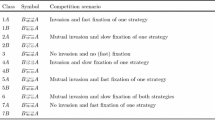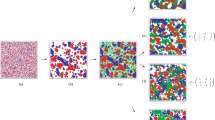Abstract
We consider a dynamical model for evolutionary games, and enquire how the introduction of diffusion may lead to the formation of stationary spatially inhomogeneous solutions, that is patterns. For the model equations being used it is already known that if there is an evolutionarily stable strategy (ESS), then it is stable. Equilibrium solutions which are not ESS's and which are stable with respect to spatially constant perturbations may be unstable for certain choices of the dispersal rates. We prove by a bifurcation technique that under appropriate conditions the instability leads to patterns. Computations using a curve-following technique show that the bifurcations exhibit a rich structure with loops joined by symmetry-breaking branches.
Similar content being viewed by others
References
Armbruster, D., Dangelmayr, G.: Coupled stationary bifurcations in non-flux boundary value problems. Math. Proc. Camb. Philos. Soc. 101, 167–192 (1987)
Ascher, V. M., Mattheij, M., Russel, R. D.: Numerical solutions of boundary value problems for ordinary differential equations. Englewood Cliffs, NJ: Prentice-Hall 1988
Berger, M. S.: Nonlinearity and Functional Analysis. New York: Academic Press 1977
Caristi, G., Rybakowski, K. P., Wessolek, T.: Persistence and spatial patterns in a one-predator—two-prey Lotka-Volterra model with diffusion. Ann. Mat. Pura Appl. (in press)
Doedel, E. AUTO: A program for the automatic bifurcation analysis of autonomous systems. Cong. Num. 30, 265–284 (1981)
Eilbeck, J. C.: Pattern formation and pattern selection in reaction-diffusion systems. In: Goodwin, B, Saunders, P. T. (eds.) Theoretical Biology: Epigenetic and Evolutionary Order from Complex Systems (Waddington Memorial Conference), pp. 31–44. Edinburgh University Press 1989
Fisher, R. A.: The wave of advance of an advantageous gene. Ann. Eugen. 7, 355–369 (1937)
Golubitsky, M., Schaeffer, D.: Singularities and groups in bifurcation theory, vol. 1. Berlin Heidelberg New York: Springer 1985
Hadeler, K. P.: Diffusion in Fisher's population model. Rocky Mt. J. Math. 11, 39–45 (1981)
Haigh, J.: Game theory and evolution. Adv. Appl. Probab. 7, 8–11 (1975)
Hutson, V. C. L., Vickers, G. T.: Travelling waves and dominance of ESS's. J Math. Biol. 30, 457–471 (1992)
Maynard Smith, J., Price, G. R.: The logic of animal conflict. Nature, Lond. 246, 15–18 (1973)
Maynard Smith, J.: The theory of games and the evolution of animal conflicts. J Theor. Biol. 47, 209–221 (1974)
Taylor, P. D., Jonker, L. B.: ESS and game dynamics. Math. Biosci. 40, 145–156 (1978)
Vickers, G. T., Cannings, C.: Patterns of ESS's I. J. Theor. Biol. 132, 387–408 (1988)
Vickers, G. T.: Spatial patterns and ESS's. J. Theor. Biol. 140, 129–135 (1989)
Zeeman, E. C.: Global Theory of Dynamical Systems. In: Nitecki, Z., Robinson, C. (eds.) Proceedings of the Symposium of Northwestern University 1979. Berlin Heidelberg New York: Springer 1980
Author information
Authors and Affiliations
Rights and permissions
About this article
Cite this article
Vickers, G.T., Hutson, V.C.L. & Budd, C.J. Spatial patterns in population conflicts. J. Math. Biol. 31, 411–430 (1993). https://doi.org/10.1007/BF00163924
Received:
Revised:
Issue Date:
DOI: https://doi.org/10.1007/BF00163924




